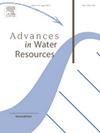Homogenization-informed convolutional neural network to predict permeability and dispersion in porous media
IF 4.2
2区 环境科学与生态学
Q1 WATER RESOURCES
引用次数: 0
Abstract
Understanding the transport properties of fluids through porous media is crucial in a wide range of scientific and engineering applications. Accurately predicting key parameters, such as permeability and effective dispersion, is essential for optimizing these processes. These parameters depend not only on the pore-scale geometry but also on flow conditions, and are traditionally expensive to compute since they are generally determined by solving direct numerical simulations on macroscopic pore-scale domains. Such computational costs limit the effectiveness of data-driven approaches in terms both of predictive accuracy and/or types of geometries that can be accurately handled. This is because the computational cost for training over a broad set of topologies and dynamic conditions is prohibitive. In this work, we propose an approach that combines deep learning with multiscale modeling techniques, and exploits the computational efficiency of homogenization theory for periodic domains to support a data-driven technique. By using only a unit cell for training purposes, we are able to generate a large dataset of porous media images and corresponding permeability and dispersion tensors at a significantly reduced computational cost, while spanning an unprecedented range of the geometric and dynamic parameter space. The dataset is composed of 10,000 images, is designed to include a wide variety of morphological properties and serves as the training set for a Convolutional Neural Network (CNN) that estimates permeability and dispersion tensors from both microstructural images and input flow conditions described by the Péclet number. The CNN can quickly and accurately characterize effective properties (permeability and dispersion tensors) spanning more than three orders of magnitude for a wide range of pore-scale topologies and flow regimes. These results highlight the potential to enhance porous media characterization and prediction in various fields.
基于均质化的卷积神经网络预测多孔介质的渗透率和分散性
了解流体在多孔介质中的输运特性在广泛的科学和工程应用中是至关重要的。准确预测关键参数,如渗透率和有效色散,对于优化这些过程至关重要。这些参数不仅取决于孔隙尺度的几何形状,还取决于流动条件,而且由于它们通常是通过在宏观孔隙尺度域上直接求解数值模拟来确定的,因此传统上计算成本很高。这样的计算成本限制了数据驱动方法在预测精度和/或可以精确处理的几何形状类型方面的有效性。这是因为在一组广泛的拓扑和动态条件下进行训练的计算成本令人望而却步。在这项工作中,我们提出了一种将深度学习与多尺度建模技术相结合的方法,并利用周期域均匀化理论的计算效率来支持数据驱动技术。通过仅使用单元格进行训练,我们能够以显着降低的计算成本生成多孔介质图像和相应的渗透率和弥散张量的大型数据集,同时跨越前所未有的几何和动态参数空间范围。该数据集由10,000张图像组成,旨在包含各种各样的形态属性,并作为卷积神经网络(CNN)的训练集,该神经网络可以从微结构图像和psamclet数描述的输入流条件中估计渗透率和弥散张量。CNN可以快速准确地表征超过三个数量级的有效特性(渗透率和分散系数),适用于广泛的孔隙尺度拓扑结构和流动状态。这些结果突出了在各个领域加强多孔介质表征和预测的潜力。
本文章由计算机程序翻译,如有差异,请以英文原文为准。
求助全文
约1分钟内获得全文
求助全文
来源期刊

Advances in Water Resources
环境科学-水资源
CiteScore
9.40
自引率
6.40%
发文量
171
审稿时长
36 days
期刊介绍:
Advances in Water Resources provides a forum for the presentation of fundamental scientific advances in the understanding of water resources systems. The scope of Advances in Water Resources includes any combination of theoretical, computational, and experimental approaches used to advance fundamental understanding of surface or subsurface water resources systems or the interaction of these systems with the atmosphere, geosphere, biosphere, and human societies. Manuscripts involving case studies that do not attempt to reach broader conclusions, research on engineering design, applied hydraulics, or water quality and treatment, as well as applications of existing knowledge that do not advance fundamental understanding of hydrological processes, are not appropriate for Advances in Water Resources.
Examples of appropriate topical areas that will be considered include the following:
• Surface and subsurface hydrology
• Hydrometeorology
• Environmental fluid dynamics
• Ecohydrology and ecohydrodynamics
• Multiphase transport phenomena in porous media
• Fluid flow and species transport and reaction processes
 求助内容:
求助内容: 应助结果提醒方式:
应助结果提醒方式:


